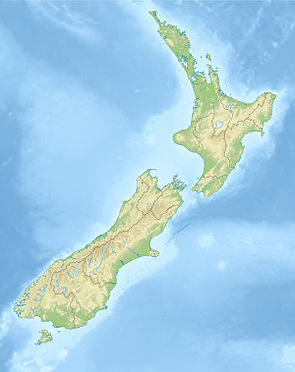Tawarau Conservation Area
| Tawarau Conservation Area | ||
| Geographical location | ||
|
|
||
| Coordinates | 38 ° 19 ′ S , 174 ° 52 ′ E | |
| Country : | New Zealand | |
| Region (s) : | Waikato | |
| Location: | 15 km and 23 km west of Te Kuiti |
|
| Protected area | ||
| Protected area type: | Conservation Area | |
| expansion | ||
| Number of areas: | 2 | |
| Rivers : | Tawarau River | |
| The Office Department of Conservation | ||
| Office: |
Te Kuiti Office 78 Taupiri Street Te Kuiti 3910 |
|
The Tawarau Conservation Area is a protected area in the Waikato region of the North Island of New Zealand . The area is under the Department of Conservation .
geography
The Tawarau Conservation Area consists of two separate areas, 15 km and 23 km west of Te Kuiti and around 24 km south of Kawhia Harbor . The western area has a length extension of 7.2 km in north-south direction and a maximum width of 3.6 km and the eastern area measures a maximum of 5.8 km in north-south direction and in east-west direction its widest point 5.5 km. Both areas are only 1.9 km apart.
The nature reserves can be reached via the New Zealand State Highway 37 , which branches off to the west from New Zealand State Highway 3 north of Te Kuiti, and its country road, which continues behind the Waitomo Caves and which passes both areas to the north.
Flora and fauna
The forest of the Tawarau Conservation Area is one of the best preserved pristine forests in the North Island of New Zealand. It is dominated by tree species such as the Tawa , Hinau , Kamahi and Rewarewa known in the Māori language , as well as stone beef species such as Rimu and Miro . The endemic Cordyline indivisa , also known as the Mountain Cabbage Tree among New Zealanders, can also be found in the cool climate of the mountains .
In addition to numerous species of birds, such as falcons , Maori ygons , Maori flycatchers and the Maori fruit pigeons , which are called under Māori Kererū , there are also the green panties , the Maori bell honey eater , the white-headed and in summer the long -tailed cuckoo , which is called long-tailed cuckoo in New Zealand , to find. The New Zealand lobed bat also lives in the forest areas. Among the small animals, the snails should be emphasized, which are represented in 82 different species in the forest.
Web links
- Tawarau Conservation Area . Department of Conservation,accessed April 12, 2020.
Individual evidence
- ↑ Tawarau Conservation Area . Department of Conservation , accessed April 12, 2020 (English, map).
- ↑ Coordinates and longitudes were determined using Goggle Earth Pro Version 7.3.2.5776 on April 12, 2020
- ↑ Topo maps . Land Information New Zealand , accessed April 12, 2020 .
- ↑ a b Tawarau Conservation Area . Department of Conservation , accessed April 12, 2020 .
